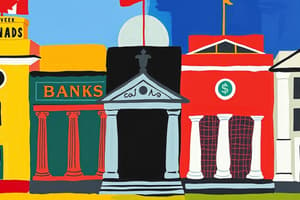Podcast
Questions and Answers
What is the minimum number of musicians required for a big band?
What is the minimum number of musicians required for a big band?
- Ten (correct)
- Twelve
- Eight
- Five
What is the purpose of big bands in jazz music?
What is the purpose of big bands in jazz music?
- To experiment with different musical genres
- To play written compositions and arrangements (correct)
- To perform for small audiences
- To showcase improvisation
Which era did big bands dominate jazz music?
Which era did big bands dominate jazz music?
- The 1940s (correct)
- The 1950s
- The 1920s
- The 1930s
What are the four sections of a big band?
What are the four sections of a big band?
What is a 'chart' in big band music?
What is a 'chart' in big band music?
Who were the major 'black' bands of the 1930s apart from Ellington's?
Who were the major 'black' bands of the 1930s apart from Ellington's?
Who were the principal fans of big bands in the late 1930s and early 1940s?
Who were the principal fans of big bands in the late 1930s and early 1940s?
What was the impact of big bands during World War II?
What was the impact of big bands during World War II?
What is the lasting influence of big band music on American popular music?
What is the lasting influence of big band music on American popular music?
Flashcards
What are big bands?
What are big bands?
Musical ensembles featuring at least 10 musicians, divided into four sections: saxophones, trumpets, trombones, and a rhythm section.
What was the most popular jazz style during the big band era?
What was the most popular jazz style during the big band era?
Swing music, a style characterized by a lively and energetic rhythm, dominated the jazz scene.
How are big band songs often organized?
How are big band songs often organized?
Arrangers often write out most or all of the music for a song, known as a "chart", giving the band a structured framework to follow.
What is the typical form of big band arrangements?
What is the typical form of big band arrangements?
Signup and view all the flashcards
Who are some of the most famous big band leaders?
Who are some of the most famous big band leaders?
Signup and view all the flashcards
How did big bands contribute to the Civil Rights Movement?
How did big bands contribute to the Civil Rights Movement?
Signup and view all the flashcards
Which famous singers began their careers with big bands?
Which famous singers began their careers with big bands?
Signup and view all the flashcards
Why did big band music lose popularity after World War II?
Why did big band music lose popularity after World War II?
Signup and view all the flashcards
How do big bands influence music today?
How do big bands influence music today?
Signup and view all the flashcards
Study Notes
Big Bands in Jazz Music: A Detailed Overview
-
Big bands are musical ensembles that consist of ten or more musicians with four sections: saxophones, trumpets, trombones, and a rhythm section.
-
They originated during the 1910s and dominated jazz in the early 1940s when swing was most popular.
-
Big bands were created as accompaniment for dancing and relied on written compositions and arrangements rather than improvisation.
-
They generally have four sections: trumpets, trombones, saxophones, and a rhythm section of guitar, piano, double bass, and drums.
-
Arrangers frequently notate all or most of the score of a given number, usually referred to as a "chart".
-
Typical big band arrangements from the swing era were written in strophic form with the same phrase and chord structure repeated several times.
-
The major "black" bands of the 1930s included, apart from Ellington's, Hines's and Calloway's, those of Jimmie Lunceford, Chick Webb, and Count Basie.
-
White teenagers and young adults were the principal fans of the big bands in the late 1930s and early 1940s.
-
Big bands uplifted morale during World War II and many musicians served in the military and toured with USO troupes at the front.
-
Although big bands are identified with the swing era, they continued to exist after those decades, though the music they played was often different from swing.
-
Charlie Barnet's recording of "Cherokee" in 1942 and "The Moose" in 1943 have been called the beginning of the bop era.
-
Sun Ra and his Arketstra took big bands further out, playing eclectic music with a roster of musicians from ten to thirty and presenting it as theater, with costumes, dancers, and special effects.The History and Legacy of Big Bands
-
Big bands emerged in the early 20th century, with the likes of Duke Ellington, Count Basie and Benny Goodman becoming prominent bandleaders.
-
The big band era reached its peak in the 1930s and 1940s, with swing music becoming the most popular genre in America.
-
The big band sound is characterized by a large ensemble consisting of brass, woodwind, and rhythm sections, with arrangements often featuring call-and-response patterns between different sections.
-
Big bands played a significant role in the integration of African American and white musicians during the Civil Rights Movement.
-
Many famous vocalists, including Frank Sinatra and Ella Fitzgerald, got their start singing with big bands.
-
Big band music declined in popularity after World War II due to changing musical tastes and the rise of rock and roll.
-
However, big bands continued to evolve and incorporate new styles, such as jazz fusion and avant-garde jazz.
-
In the late 1990s, there was a swing revival in the U.S. that renewed interest in big band music.
-
Big bands continue to maintain a presence on American television and in music education programs at colleges and universities.
-
Big bands also appeared in movies, with fictionalized biographical films of Glenn Miller, Gene Krupa, and Benny Goodman being made in the 1950s.
-
Female bandleaders, such as Gloria Parker and Phil Spitalny, led all-girl orchestras during the big band era.
-
Big band music has had a lasting influence on American popular music, with many contemporary artists drawing inspiration from the genre.
Studying That Suits You
Use AI to generate personalized quizzes and flashcards to suit your learning preferences.




